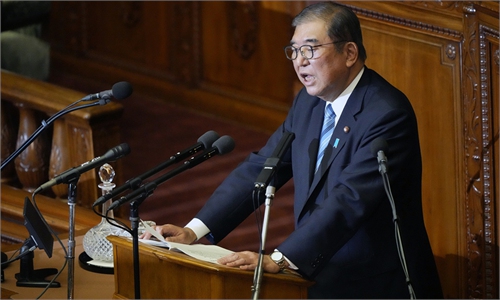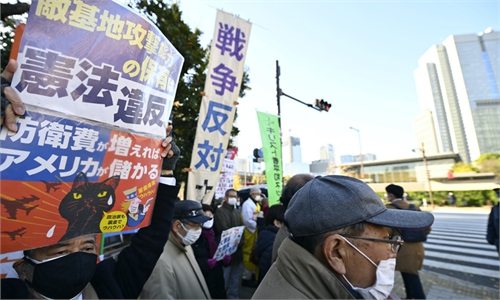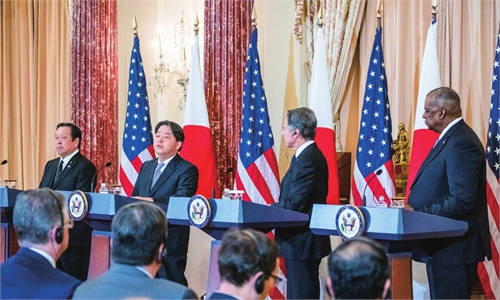Japan plans to expand OSA aid to align with US’ Indo-Pacific strategy and pursue military ambitions, analysts say

Latest news
Japan plans to supply defense equipment to Thailand, Tonga and six other nations in the current fiscal year as security aid, a government source said Friday, with the aim to ensure safe sea lanes in the Indo-Pacific region where China is evolving its military posture, Kyodo News reported Saturday. Meanwhile, Two Japan Maritime Self-Defense Force (JMSDF) destroyers arrived at Manila's Port Area on Saturday, Philippines local media Daily Tribune reported Sunday.
Chinese analysts reached by the Global Times on Sunday said that Japan's expansion of the official security assistance (OSA) budget and aid recipients is mainly an attempt to curry favor with the US Indo-Pacific strategy by filling the gap left by US' overstretched presence in the Middle East, while also revealing its ambition to enhance its own military influence.
The eight countries - also including East Timor, Indonesia, Malaysia, Papua New Guinea, the Philippines and Sri Lanka - are expected to be designated as the recipients of Japan's OSA framework, designed for like-minded partners, for fiscal 2025 from April, the Kyodo News citing the sources reported.
The defense equipment includes things such as unmanned aerial vehicle drones and high-speed patrol boats. In addition to Japan's domestically made drones, the government plans to provide military vessels for search and rescue missions and heavy machineries to be utilized in the event of disasters, according to the Japan Times.
The government is considering providing them Japanese-made drones to help in their natural disaster relief and maritime surveillance missions, reported the Kyodo News citing the resource.
Meanwhile, two JMSDF destroyers arrived at Manila's Port Area on Saturday for a so-called three-day goodwill visit, underscoring the growing naval cooperation between Japan and the Philippines following the ratification of their Reciprocal Access Agreement, Daily Tribune reported Sunday.
The JS Ise, a Hyuga-class helicopter destroyer, and the JS Suzunami, a Takanami-class destroyer, docked at 10:30 am as part of the JMSDF's Indo-Pacific Deployment 2025. The mission claims to aim at promoting regional security and strengthening partnerships with allied navies through joint exercises.
Japan launched the OSA scheme in April 2023 to help developing countries, claiming that its aim at strengthening their defense capabilities amid security concerns such as the Chinese forces' increasing assertiveness at sea and in the air, said in a Kyodo report.
Japan's new framework essentially reflects the militarization and weaponization of its foreign aid strategy, Xiang Haoyu, a research fellow at the China Institute of International Studies, told the Global Times.
Xiang noted that the initiative serves three main strategic purposes. First, it seeks to expand Japan's political influence in the Indo-Pacific and support its push to loosen long-standing military restrictions. Second, it aligns with the US Indo-Pacific strategy, aiming to counterbalance China's regional security influence. Third, it helps Japan promote its defense exports and open up new markets for its arms industry.
In the past two fiscal years through 2024, Bangladesh, Djibouti, Fiji, Indonesia, Malaysia, Mongolia and the Philippines were recipients of the assistance program.
In its fiscal 2025 initial budget, Japan earmarked 8.1 billion yen ($56 million) for OSA assistance, up from 2 billion yen in fiscal 2023 and 5 billion yen in fiscal 2024, said the report.
Japan's defense budget has not only increased year by year in recent years but has also grown at a rapid pace, driving its expanding military outreach, Lü Xiang, a research fellow at the Chinese Academy of Social Sciences, told the Global Times.
Lü noted that, on one hand, amid rising tensions in the Middle East, the US may find itself overstretched and unable to focus on all fronts, giving Japan an opportunity to fill the gap. On the other hand, Japan is seeking to enhance its military influence in these countries.
"Such moves imply an intention to divide regional countries and create bloc confrontations, which may provoke tensions and increase the risk of localized geopolitical conflicts — a development that is detrimental to regional peace, stability, and cooperative unity," Xiang added.
Previously, Chinese Foreign Ministry spokespersons have repeatedly stated China's consistent position that cooperation between countries, including military and security ties, should not target any third party or harm their interests, or undermine regional peace and stability.



